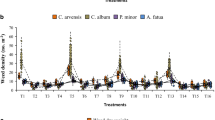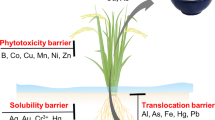Abstract
The presence of arsenic in irrigation water and in paddy field soil were investigated to assess the accumulation of arsenic and its distribution in the various parts (root, straw, husk, and grain) of rice plant from an arsenic effected area of West Bengal. Results showed that the level of arsenic in irrigation water (0.05–0.70 mg l−1) was much above the WHO recommended arsenic limit of 0.01 mg l−1 for drinking water. The paddy soil gets contaminated from the irrigation water and thus enhancing the bioaccumulation of arsenic in rice plants. The total soil arsenic concentrations ranged from 1.34 to 14.09 mg kg−1. Soil organic carbon showed positive correlation with arsenic accumulation in rice plant, while soil pH showed strong negative correlation. Higher accumulation of arsenic was noticed in the root (6.92 ± 0.241–28.63 ± 0.225 mg kg−1) as compared to the straw (1.18 ± 0.002–2.13 ± 0.009 mg kg−1), husk (0.40 ± 0.004–1.05 ± 0.006 mg kg−1), and grain (0.16 ± 0.001–0.58 ± 0.003 mg kg−1) parts of the rice plant. However, the accumulation of arsenic in the rice grain of all the studied samples was found to be between 0.16 ± 0.001 and 0.58 ± 0.003 mg kg−1 dry weights of arsenic, which did not exceed the permissible limit in rice (1.0 mg kg−1 according to WHO recommendation). Two rice plant varieties, one high yielding (Red Minikit) and another local (Megi) had been chosen for the study of arsenic translocation. Higher translocation of arsenic was seen in the high yielding variety (0.194–0.393) compared to that by the local rice variety (0.099–0.161). An appreciable high efficiency in translocation of arsenic from shoot to grain (0.099–0.393) was observed in both the rice varieties compared to the translocation from root to shoot (0.040–0.108).



Similar content being viewed by others
References
Abedin MJ, Cresser MS, Meharg AA, Feldmann J, Cotter-Howells J (2002a) Arsenic accumulation and metabolism in rice (Oryza sativa L.). Environ Sci Technol 36(5):962–968
Abedin MJ, Feldmann J, Meharg AA (2002b) Uptake kinetics of arsenic species in rice plants. Plant Physiol 128:1120–1128
Alam MZ, Rahman MM (2003) Accumulation of arsenic in rice plant from arsenic contaminated irrigation water and effect on nutrient content. In: Ahmed F, Ali MA, Adeel Z (eds) BUET-UNU International symposium of fate of arsenic in the environment, Dhaka, Bangladesh. Conference paper, pp 131–135
Chakraborty AK, Das DK (1997) Arsenic pollution and its environmental significance. J Interacad 1:262–276
Chakraborty D, Rahman MM, Paul K, Chowdhury UK, Sengupta MK, Lodh D, Chanda CR, Saha KC, Mukherjee SC (2002) Arsenic calamity in the Indian subcontinent—what lessons have been learnt? Talanta 58:3–22
Das D, Chatterjee C, Mandal BK, Samanta G, Chakraborty D (1995) Arsenic in groundwater in six districts of West Bengal, India: the biggest arsenic calamity in the World, Part-2: arsenic concentration in drinking water, hair, nails, urine, skin scale and liver tissue (biopsy) of the affected people. Analyst 120:917–924
Das HK, Mitra AK, Sengupta PK, Hossain A, Islam F, Rabbani GH (2004) Arsenic concentrations in rice, vegetables and fish in Bangladesh: a preliminary study. Environ Int 30(3):383–387
Delowar HKM, Yoshida I, Harada M, Sarkar AA, Miah MNH, Razzaque AHM, Uddin MI, Adhana K, Perveen MF (2005) Growth and uptake of arsenic by rice irrigated with As-contaminated water. J Food Agric Environ 3(2):287–291
ICAR (2001) Final report: status causes and impact of arsenic contaminant in groundwater in parts of West Bengal vis-à-vis management of agricultural systems. [Adhoc scheme executed (1998–2001) by BCKV (Nodal Center); NBSS and LUP, Regional Center, Kolkata; NDRI, Kalyani; GSI, Government of India, Kolkata; CSSRI, Regional Research Station, Canning Town; SWID, Government of West Bengal, Kolkata; Principal Investigator—Sanyal, S.K.]
Islam MR, Jahiruddin M, Rahman GKMM, Miah MAM, Farid ATM, Panaullah GM, Loeppert RH, Duxbury JM, Meisner CA (2004) Assessment of arsenic in the water-soil-plant systems in gangetic flood plains of Bangladesh. Asian J Plant Sci 3:489–493
Liu WJ, Zhu YG, Smith SA, Smith SE (2004) Do iron plaque and genotypes affect arsenate uptake and translocation by rice seedlings (Oryza sativa L.) grown in solution culture. J Exp Bot 55(403):1707–1713
Liu WJ, Zhu YG, Hu Y, Williams PN, Gault AG, Meharg AA, Charnock JM, Smith FA (2006) Arsenic sequestration in iron plaque, its accumulation and speciation in mature rice plants (Oryza sativa L.). Environ Sci Technol 40:5730–5736
Mandal B, Hazra GC (1997) Zinc absorption in soils as influenced by different soil management practices. Soil Sci 162:713–721
Mandal BK, Chowdhury TR, Samanta G, Basu GK, Chowdhury PP, Chanda CR, Lodh D, Karan NK, Dhar RK, Tamili DT, Das D, Saha KC, Chakraborty D (1996) Chronic arsenic toxicity in West Bengal. Curr Sci 72(2):114–117
Marchiol L, Assolari S, Sacco P, Zebri G (2004) Phytoextraction of heavy metals by canola (Brassica napus) and radish (Raphanus sativus) grown on ulticontaminated soil. Environ Pollut 132:21–27
Meharg AA (2004) Arsenic in rice-understanding a new disaster for South-East Asia. Trends Plant Sci 9:415–417
Meharg AA, Rahman MM (2003) Arsenic contamination of Bangladesh paddy field soil: implication for rice contribution to arsenic consumption. Environ Sci Technol 37(2):224–234
Nickson RT, McArthur JM, Ravenscroft P, Burgess WG, Ahmed KM (2000) Mechanism of arsenic release to groundwater, Bangladesh and West Bengal. Appl Geochem 15:403–413
Norra S, Berner ZA, Agarwala P, Wagner F, Chandrasekharam D, Stüben D (2005) Impact of irrigation with arsenic rich groundwater on soil and crops: a geochemical case study in West Bengal delta plain. India Appl Geochem 20:1890–1906
O’Neil P (1995) Heavy metals in soils. In: Alloway BJ (ed) Arsenic. Blackie Academic and Professional, London, pp 105–121
Ohno K, Yanase T, Matsuo Y, Kimura T, Rahman MH, Magara Y, Matsui Y (2007) Arsenic intake via water and food by a population living in an arsenic-affected area of Bangladesh. Sci Total Environ 381:68–76
Onken BM, Hossner LR (1995) Plant uptake and determination of arsenic species in soil solution under flooded conditions. Environ Qual 24:373–381
Rahman MA, Rahman MM, Majid Miah MA, Khaled HM (2004) Influence of soil arsenic concentrations on rice (Oryza sativa L.). Subtrop Agric Res Dev 2(3):24–31
Rahman MA, Hasegawa H, Rahman MM, Rahman MA, Miah MAM (2007) Accumulation of arsenic in tissues of rice plant (Oryza sativa L.) and its distribution in fractions of rice grain. Chemosphere 69:942–948
Rahman MA, Hasegawa H, Rahman MM, Miah MAM, Tasmin A (2008) Arsenic accumulation in rice (Oryza sativa L.): Human exposure through food chain. Ecotoxicol Environ Saf 69:317–324
Roychowdhury T, Uchino T, Tokunga H, Ando M (2002) Survey of arsenic in food composites from an arsenic-affected area of West Bengal, India. Food Chem Toxicol 40:1611–1621
Samal AC (2005) An investigation on accumulation of arsenic in ecosystem of Gangetic West Bengal and assessment of potential health risk. Ph. D Thesis, University of Kalyani, Kalyani, Nadia, West Bengal, India
Smith E (1998) Arsenic in the environment: a review. In: Advances in agronomy. Academic Press, Australia, 64 pp
Smith AH, Lingas EO, Rahman M (2000) Contamination of drinking water by arsenic in Bangladesh: a public health emergency. Bull WHO 78(9):1093–1103
Tiwari RC, Kumar BM (1982) A suitable extracting for assessing plant-available copper in different soils (peaty, red and alluvial). Plant Soil 68:131–134
Ullah SM (1998) Arsenic contamination of groundwater and irrigated soils of Bangladesh. In: International conference on arsenic pollution of groundwater in Bangladesh: causes, effects and remedies. Dhaka Community Hospital, Dhaka, Bangladesh, 133 pp
Walkey A, Black IA (1934) An examination of the Degtjareff method for determining soil organic matter and a proposed modification of the chromic acid titration method. Soil Sci 37:29–38
Welsch FP, Crock JG, Sanzolone R (1990) Trace elements determination of arsenic and selenium using continuous-flow hydride generation atomic absorption spectrophotometry (HG-AAS). In: Arbogast BF (ed) Quality assurance manual for the branch of geochemistry, pp 38–45
WHO (1992) Guideline for drinking water quality, recommendation, vol 1, 2nd edn. World Health Organization, Geneva, 41 pp
Williams PN, Islam MR, Raab A, Hossain SA, Meharg AA (2006) Increase in rice grain arsenic for regions of Bangladesh irrigating paddies with elevated arsenic in groundwater. Environ Sci Technol 40:4903–4908
Zhao R, Zhao M, Wang H, Taneike Y, Zhang X (2006) Arsenic speciation in moso bamboo shoot—a terrestrial plant that contains organoarsenic species. Sci Total Environ 371:293–303
Acknowledgments
Authors are thankful to the Department of Environment, Government of West Bengal, India for providing fund to carry out the investigation. We are also thankful to the Department of Environmental Science, University of Kalyani, West Bengal, India for providing us the laboratory facilities. Piyal Bhattacharya is thankful to the Department of Environment, Government of West Bengal, India for the award of Junior Research Fellowship.
Author information
Authors and Affiliations
Corresponding author
Rights and permissions
About this article
Cite this article
Bhattacharya, P., Samal, A.C., Majumdar, J. et al. Accumulation of arsenic and its distribution in rice plant (Oryza sativa L.) in Gangetic West Bengal, India. Paddy Water Environ 8, 63–70 (2010). https://doi.org/10.1007/s10333-009-0180-z
Received:
Accepted:
Published:
Issue Date:
DOI: https://doi.org/10.1007/s10333-009-0180-z




